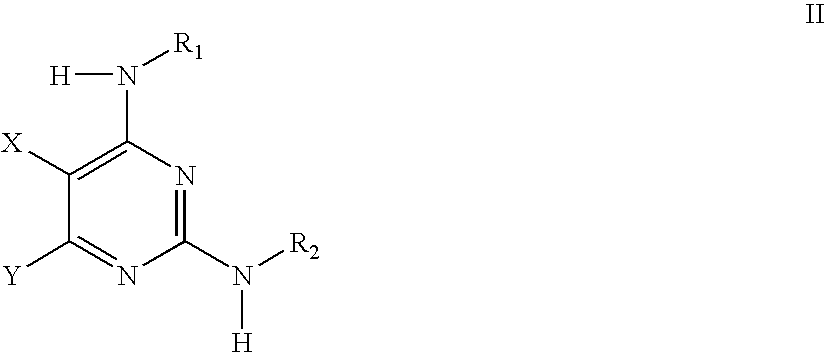Pyrimidine Derivatives As Kinase Modulators and Method of Use
a technology of pyrimidine derivatives and kinase, which is applied in the direction of heterocyclic compound active ingredients, biocide, drug compositions, etc., can solve the problems of neither compound being able to inhibit t315i, unable to achieve the effect of t315i inhibition, and altered cellular properties
- Summary
- Abstract
- Description
- Claims
- Application Information
AI Technical Summary
Problems solved by technology
Method used
Image
Examples
example 1
N4-(5-Isopropyl-1H-pyrazol-3-yl)-N6-[2-(4-methylpiperazin-1-yl)ethyl]-N2-(3-phenylisoxazol-5-ylmethyl)-pyrimidine-2,4,6-triamine
[0291]
[0292]4-Methyl-3-oxopentanenitrile. A solution of acetonitrile (25.2 mL, 480 mmol) in THF (300 mL) was cooled to −78° C. in a dry ice / acetone bath, and n-butyllithium (255 mL, 1.6 M in hexanes, 408 mmol) was added dropwise. The solution was stirred at −78° C. for 2 h and isobutyril chloride (25.2 mL, 240 mmol) was added dropwise. The reaction was maintained at −78° C. for 1 h, allowed to warm to room temperature for 2 h and then stored in a refrigerator overnight. The reaction was quenched with 3 N HCl, extracted with ether, washed with water and brine and dried over sodium sulfate. The solvent was removed on a rotary evaporator to give the desired product (25 g, 94%) as a light brown oil that was used without further purification.
[0293]5-Isopropyl-1H-pyrazol-3-ylamine. A solution of 4-methyl-3-oxopentanenitrile (25 g, 225 mmol) and hydrazine (6.75 mL...
example 2
N4-(5-Cyclopropyl-1H-pyrazol-3-yl)-6-methyl-N2-(3-phenylisoxazol-5-ylmethyl)-pyrimidine-2,4,6-triamine
[0299]
[0300]2-Chloro-6-methylpyrimidin-4-yl-(5-cyclopropyl-1H-pyrazol-3-yl)-amine. A mixture of 2,4-dichloro-6-methylpyrimidine (30.0 g, 184 mmol), 5-cyclopropyl-1H-pyrazol-3-ylamine (22.6 g, 184 mmol) and diisopropylethylamine (46 mL, 278 mmol) in 1-butanol (50 mL) was heated to 60° C. for 65 h. The reaction was cooled to room temperature and diluted with ethyl acetate. The mixture was washed with 2 N sodium hydroxide, water and brine, then dried over sodium sulfate and concentrated on a rotary evaporator. The residue was treated with a small amount of acetonitrile, sonicated and then triturated with ether until a solid was formed. The solid was collected by filtration to give the desired product (23.0 g, 50%) as a yellow solid.
[0301]N4-(5-Cyclopropyl-1H-pyrazol-3-yl)-6-methyl-N2-(3-phenylisoxazol-5-ylmethyl)-pyrimidine-2,4,6-triamine. A mixture of 2-chloro-6-methylpyrimidin-4-yl-(...
example 3
5-Bromo-N4-(5-cyclopropyl-1H-pyrazol-3-yl)-N2-(4-dimethylaminobenzyl)-pyrimidine-2,4-diamine
[0303]
[0304]5-Bromo-2-chloropyrimidin-4-yl-(5-cyclopropyl-1H-pyrazol-3-yl)-amine. A mixture of 5-bromo-2,4-dichloropyrimidine (15.4 g, 67.6 mmol), 5-cyclopropyl-1H-pyrazol-3-ylamine (10.0 g, 81.3 mmol) and diisopropylethylamine (17 mL, 102 mmol) in 1-butanol (150 mL) was heated to 80° C. for 1 h. The solid that formed was collected by filtration and washed with acetonitrile to give the desired product (15.8 g, 75%) as a white solid.
[0305]5-Bromo-N4-(5-cyclopropyl-1H-pyrazol-3-yl)-N2-(4-dimethylaminobenzyl)-pyrimidine-2,4-diamine. A mixture of 5-bromo-2-chloropyrimidin-4-yl-(5-cyclopropyl-1H-pyrazol-3-yl)-amine (313 mg, 1.00 mmol) and 4-dimethylaminobenzylamine (225 mg, 1.5 mmol) in 1-butanol (20 mL) was heated to 170° C. in a 50 mL sealed tube for 3 h. The mixture was cooled and diluted with ethyl acetate. The organic layer was washed with 2 N sodium hydroxide, water and brine and dried over ...
PUM
| Property | Measurement | Unit |
|---|---|---|
| body weight | aaaaa | aaaaa |
| temperature | aaaaa | aaaaa |
| temperature | aaaaa | aaaaa |
Abstract
Description
Claims
Application Information
 Login to View More
Login to View More - R&D
- Intellectual Property
- Life Sciences
- Materials
- Tech Scout
- Unparalleled Data Quality
- Higher Quality Content
- 60% Fewer Hallucinations
Browse by: Latest US Patents, China's latest patents, Technical Efficacy Thesaurus, Application Domain, Technology Topic, Popular Technical Reports.
© 2025 PatSnap. All rights reserved.Legal|Privacy policy|Modern Slavery Act Transparency Statement|Sitemap|About US| Contact US: help@patsnap.com



